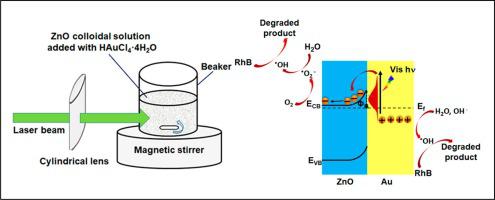Optics & Laser Technology ( IF 4.6 ) Pub Date : 2020-08-20 , DOI: 10.1016/j.optlastec.2020.106533 Chujun Yao , Wenguang Chen , Lequn Li , Kai Jiang , Zhigao Hu , Jiamin Lin , Ning Xu , Jian Sun , Jiada Wu

|
This paper presents a simple and feasible method for liquid-phase fabrication of Au-decorated ZnO (ZnO:Au) nanocomposites by two-step liquid-phase pulsed laser ablation. Pristine ZnO were first prepared by pulsed laser ablation of zinc powers in water, and ZnO:Au nanocomposites were then synthesized by decorating the pristine ZnO with Au nanoparticles also via liquid-phase pulsed laser ablation. The prepared ZnO:Au NCs were characterized in liquid and solid phases for morphology, structure and optical properties, and used as photocatalysts for the evaluation of photocatalytic activity. The ZnO:Au nanocomposites are composed of Au nanoparticles surrounded by polycrystalline wurtzite ZnO, present high light absorption in the ultraviolet and visible region and have a plasmonic absorption band around 530 nm. Unlike pristine ZnO which has photocatalytic activity only in the ultraviolet region, the incorporation of Au nanoparticles with ZnO results in high photocatalytic activity in the ultraviolet as well as in the visible region by significantly enhancing the photogeneration of charge carriers and promoting the separation of the photogenerated charge carriers. Using Rhodamine B as a representative organic pollutant, the ZnO:Au nanocomposites were demonstrated to exhibit excellent photocatalytic performance as visible photocatalysts for the degradation of organic pollutants. Compared with pristine ZnO, the rate constant for the photodegradation of Rhodamine B with the ZnO:Au nanocomposites is nearly doubled under visible illumination.
中文翻译:

液相脉冲激光烧蚀制备具有高光催化活性的ZnO:Au纳米复合材料
本文提出了一种两步液相脉冲激光烧蚀液相制备Au修饰的ZnO(ZnO:Au)纳米复合材料的简单可行的方法。首先通过脉冲激光烧蚀水中的锌粉来制备原始的ZnO,然后通过液相脉冲激光烧蚀用Au纳米粒子修饰原始ZnO,从而合成ZnO:Au纳米复合材料。制备的ZnO:Au NCs在液相和固相中表征其形貌,结构和光学性质,并用作光催化剂以评价光催化活性。ZnO:Au纳米复合材料由被多晶纤锌矿ZnO包围的Au纳米颗粒组成,在紫外和可见光区域呈现高光吸收,并在530 nm附近具有等离子体吸收带。与仅在紫外线区域具有光催化活性的原始ZnO不同,金纳米粒子与ZnO的结合通过显着增强电荷载流子的光生作用并促进光生物质的分离而导致在紫外线和可见光区均具有高光催化活性。电荷载体。以罗丹明B为代表的有机污染物,ZnO:Au纳米复合材料被证明具有出色的光催化性能,可作为可见光催化剂降解有机污染物。与原始ZnO相比,在可见光下,ZnO:Au纳米复合材料对罗丹明B的光降解速率常数几乎增加了一倍。Au纳米粒子与ZnO的结合通过显着增强电荷载流子的光生作用并促进光生载流子的分离,从而在紫外光和可见光区具有很高的光催化活性。以罗丹明B为代表的有机污染物,ZnO:Au纳米复合材料被证明具有出色的光催化性能,可作为可见光催化剂降解有机污染物。与原始ZnO相比,在可见光下,ZnO:Au纳米复合材料对罗丹明B的光降解速率常数几乎增加了一倍。Au纳米粒子与ZnO的结合通过显着增强电荷载流子的光生作用并促进光生载流子的分离,从而在紫外光和可见光区具有很高的光催化活性。以罗丹明B为代表的有机污染物,ZnO:Au纳米复合材料被证明具有出色的光催化性能,可作为可见光催化剂降解有机污染物。与原始ZnO相比,在可见光下,ZnO:Au纳米复合材料对罗丹明B的光降解速率常数几乎增加了一倍。以罗丹明B为代表的有机污染物,ZnO:Au纳米复合材料被证明具有出色的光催化性能,可作为可见光催化剂降解有机污染物。与原始ZnO相比,在可见光下,ZnO:Au纳米复合材料对罗丹明B的光降解速率常数几乎增加了一倍。以罗丹明B为代表的有机污染物,ZnO:Au纳米复合材料被证明具有出色的光催化性能,可作为可见光催化剂降解有机污染物。与原始ZnO相比,在可见光下,ZnO:Au纳米复合材料对罗丹明B的光降解速率常数几乎增加了一倍。











































 京公网安备 11010802027423号
京公网安备 11010802027423号